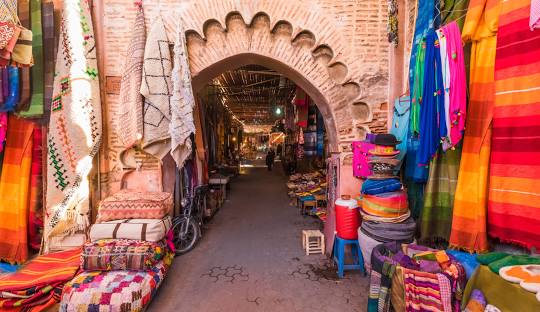Marrakech, Morocco
🌍 Marrakech, Morocco – A Journey Through Time and Culture
Overview:
Marrakech, often called the Red City due to its terracotta-hued buildings, is one of Morocco's most iconic destinations. Located at the foot of the Atlas Mountains, it blends medieval charm with modern flair, offering visitors a journey through history, architecture, art, and flavor. With bustling souks, majestic palaces, and a thriving cultural scene, Marrakech is an unforgettable sensory experience.
🌟 Top Attractions in Marrakech
🏰 Jemaa el-Fnaa Square
The heart of the city, Jemaa el-Fnaa, is a lively marketplace where street performers, food stalls, snake charmers, and henna artists create a mesmerizing atmosphere. In the evening, the square turns into an open-air food court, offering an array of traditional Moroccan dishes.
🕌 Koutoubia Mosque
Marrakech’s largest mosque, the Koutoubia, is a stunning example of Almoravid architecture. Its towering minaret (77 meters high) is a city landmark and can be seen from miles away.
🏰 Bahia Palace
A masterpiece of Moroccan architecture, Bahia Palace is a 19th-century mansion with lush gardens, intricate tile work, and beautiful courtyards. It offers a glimpse into the opulent lifestyle of Moroccan royalty.
🌳 Majorelle Garden
A serene oasis, the Majorelle Garden is filled with vibrant blue walls, exotic plants, and tranquil pools. Originally created by French painter Jacques Majorelle, the garden is now owned by the Yves Saint Laurent Foundation.
🏛️ Saadian Tombs
These beautifully decorated tombs date back to the 16th century and were hidden for centuries before being rediscovered in 1917. The tombs are an essential stop to learn about Morocco’s royal history.
🏰 El Badi Palace
Though mostly in ruins, the El Badi Palace offers a fascinating look at what was once one of the grandest palaces in Morocco. The site is now home to storks, and its open spaces allow for stunning photography opportunities.
🛍️ Shopping in Marrakech
Souks of Marrakech
The city’s ancient souks (markets) are a maze of narrow alleyways, each dedicated to specific goods—spices, textiles, leather goods, and pottery. Bargaining is a must, and the experience is a delightful chaos of colors and scents.
-
Souk Semmarine: Best for textiles, scarves, and carpets.
-
Souk Ableuh: Famous for Moroccan spices and herbs.
-
Souk El Bahja: The place to find artisan leather products.
Moroccan Handicrafts
Marrakech is famous for its craftsmanship: handwoven rugs, mosaic tiles, and leather goods (bags, slippers). These handmade products make perfect souvenirs and gifts.
🍽️ Moroccan Cuisine in Marrakech
Marrakech is a food lover’s paradise, offering a blend of traditional and modern Moroccan dishes:
-
Tagine: A slow-cooked stew with meat, vegetables, and spices, typically served in a traditional clay pot.
-
Couscous: Steamed semolina served with meat, vegetables, and sauce.
-
Pastilla: A savory-sweet pie made of flaky pastry filled with pigeon or chicken, almonds, and cinnamon.
-
Mint Tea: A traditional Moroccan drink, often served with sugar and fresh mint.
-
Street Food: Try msemmen (Moroccan flatbread), briouats (fried pastries), and kefta (grilled meatballs).
Top Dining Spots:
-
Le Jardin (charming outdoor restaurant with a garden setting)
-
Al Fassia (legendary spot for traditional Moroccan cuisine)
-
Nomad (modern Moroccan food with rooftop views)
🛌 Where to Stay in Marrakech
-
Luxury: La Mamounia – A 5-star hotel offering luxury, gardens, and palatial interiors.
-
Mid-range: Riad Kheirredine – A beautifully restored riad in the Medina with a traditional yet modern flair.
-
Budget: Equity Point Marrakech – A hostel offering a great atmosphere and affordable accommodation.
🌡️ Best Time to Visit Marrakech
-
Spring (March to May) and Fall (September to November) are the best times to visit for mild weather, perfect for exploring the city and nearby mountains.
-
Summer (June to August) can be extremely hot, with temperatures often exceeding 40°C (104°F), so be prepared for heat if you choose to visit in this season.
-
Winter (December to February) is cooler, but still enjoyable for sightseeing and shopping.
✈️ Travel Tips for Marrakech
-
Dress Modestly: While Marrakech is quite liberal compared to other Moroccan cities, it’s best to dress conservatively, especially when visiting religious sites.
-
Learn Basic Arabic or French Phrases: While many Moroccans speak English, knowing basic Arabic or French will help you navigate the city.
-
Stay Hydrated: Marrakech can get very hot, so be sure to drink plenty of water and protect yourself from the sun.
🧳 Hidden Gems & Unique Experiences
-
Jardin Secret: A lesser-known garden offering peace and tranquility away from the crowds.
-
Le Musée de la Palmeraie: A beautiful museum showcasing Moroccan contemporary art and culture.
-
Day Trip to the Atlas Mountains: Go for a trek or visit the Berber villages nestled in the Atlas peaks.
-
Camel Ride: Experience a camel ride at sunset through the desert-like palm groves just outside the city.


